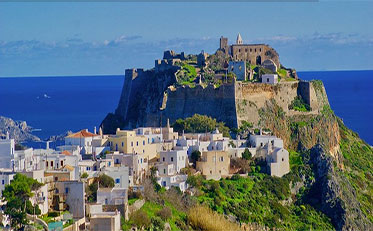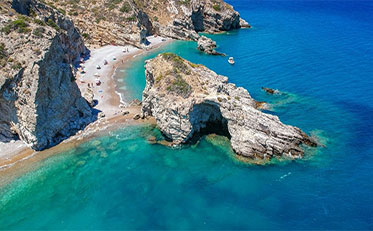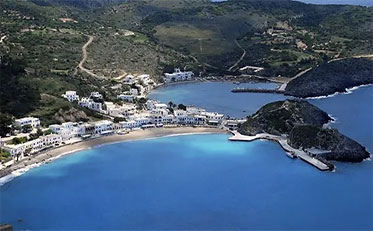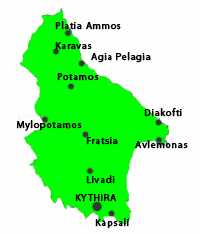|
Kythira Island
The island of Kythira lies opposite the eastern tip of the Peloponnese, Cape Malea. Its scenery is unique - rugged and dramatic, while its architecture is a blend of traditional, Aegean and Venetian elements. Over the millennia, the winds from the surrounding seas have shaped its shores into steep rocky cliffs punctuated by deep bays. Agia Pelagia is one of the island's two main ports, it is situated on its north coast 28 kilometres fromChora. This developing resort is linked by bus with the capital and the larger villages. Kythira or Chora is the island's capital, built on a hill high above the sea, is a model of Venetian defensive architecture. Its narrow streets and fortified mansions were intended as protection against pirate raids. The town is dominated by the Venetian castle (1503), which has a spectacular view of the Cretan sea. The Archaeological Museum contains an important collection of Minoan vases, Mycenaean pottery and finds from the Archaic and Classical periods.
Kapsali is the island's main tourist centre is a charming twin harbour lined by beaches - Yialos, Sparangario and Kapsalaki - "in the shadow" of the Chora's castle. Livadi: This village lies 4 kilometres from Chora on the main road between the capital and Kapsali. Here you can see the lovely old church of Agios Andreas with its 12th century frescoes. Also of interest in this area are the monasteries of Agia Elesa (4 km. SW) and the Panagia Myrtidiotissa (7 km. W), which has a superb view of the sea. Mylopotamos, is one of the most beautiful medieval villages on Kythira with exemplary traditional architecture. Among the sights worth seeing here are the miniature Venetian castle, the monastery of "the Panagia tis Orfanis", the waterfall at Fonissa and the Cave dedicated to Agia Sophia. You'll see notices in Hora announcing when the church/cave is open. Potamos (19 km. from Chora) is the largest village on the island, this is Kythira's chief marketplace. There is a Byzantine church here dedicated to the Saints Theodore and the churches of Agios loannis, Agia Anastasia and the Saviour (Sotiros) are also worth a visit for their fine icons and frescoes. Karavas is a lonely, well - watered village, 26 km. north of Chora. Kythira will appeal to those who are in search of a quiet holiday. Prospective visitors should be warned that accommodation is extremely limited at the height of summer and that the bus service between villages is not as frequent as might be desired.
History Kythira has been known since antiquity as the island of Aphrodite. At the start of the second millennium B.C. it was a Minoan colony and in 424 B.C. it came under the sway of Athens. Over the centuries it knew a succession of conquerors from the Romans to the Byzantines, Venetians and Turks, and it was frequently looted by Barbary pirates. The main town was completely destroyed in 1537 by the notorious Barbarossa. In 1717 in was rebuilt by the Venetians and in 1864 united with the Greek state.
Antikythira This small island lies 28 nautical miles south of Kythira. It was called Aigila in antiquity and was chiefly known as a pirate lair throughout the centuries. The celebrated statue of the "Youth of Antikythira" was found offshore. Its capital and port is called Potamos.
Transportation By air There are daily flights from Athens (El. Venizelos airport). By sea Ferries from Piraeus (once or twice a week) Hydrofoils from Piraeus for Kythira five times a week (weather permitting). There are also daily ferries from Neapolis-Laconia, and twice a week from Gythio-Laconia Antikythira is linked with a weekly ferry from Piraeus, Neapolis and Gythio.
|



